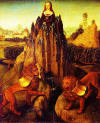Search:: Artists Alphabetically Symbolism 50 Greatest Paintings Art Movements 100 Greatest Painters
Medieval Christian Mysticism
Mysticism was widespread during the Middle Ages. Christian mystics were mostly seeking a deeper, spiritual connection with God. Mystics usually practiced meditation, prayer, and cast off their worldly belongings. Many Mystics took to the road and shared their visions with the peasant population. If a Mystics holy visions interfered with the local church hierarchy they might be accused of devilish doings or hearsay and end up being burned at the stake. Many were gifted with unexplainable visions and revelations, experienced divine ecstasy, levitation, and possessed healing powers. According to Medieval historian, Walter Pater, "The word mystic has been usually derived from a Greek word which signifies to shut, as if one shut ones lips brooding on what cannot be uttered; but the Platonists themselves derive it rather from the act of shutting the eyes, that one may see the more, inwardly."
One of the most influential mystics of the Middle Ages, Meister Eckhart, wrote "God is infinite in his simplicity and simple in his infinity. Therefore he is everywhere and is everywhere complete. He is everywhere on account of his infinity, and is everywhere complete on account of his simplicity. Only God flows into all things, their very essences. Nothing else flows into something else. God is in the innermost part of each and every thing, only in its innermost part." He was later charged with hearsay by the church.
The writings of the medieval mystics in thirteenth-century Europe opened the doors of Christian mystical ideas and rituals to an increasingly wide audience. Certain mystics and mystical movements provoked Church intervention and denunciation. Women visionaries, mystics and ecstatics were often looked upon with distrust and ended up tortured and burned at the stake during the Holy Inquisition. According to historian, Israel Abrahams "All true religion has mystical elements, for all true religion holds that man can commune with God, soul with soul. In the Psalms, God is the Rock of the heart, the Portion of the cup, the Shepherd and Light, the Fountain of Life, an exceeding Joy. All this is, in a sense, mystical language. But mysticism has many dangers. It is apt to confuse vague emotionalism and even hysteria with communion with God. A further defect of mysticism is that, in its medieval forms, it tended to the multiplication of intermediate beings, or angels, which it created to supply the means for that communion with God which, in theory, the mystics asserted was direct. Finally, from being a deep-seated, emotional aspect of religion, mysticism degenerated into intellectual sport, a play with words and a juggling with symbols."
Inspired by Christian mysticism, artists of the day produced works of amazing spiritual vitality. Their unique style is a combination of frontal simplicity, truth to nature, harmonious unity together with precision in details. The use of costly materials such as gold, precious stones and ivory indicates the degree of wealth that was common during this period, and attests to the sophistication of the Medieval society.
Church rulers endorsed certain mystics and authenticated their holy visions.
Principal Medieval
Mystics
Meister Eckhart
(1260-1328 ) charged
with heresy.
Mechthild of Magdeburg
(1208?1282)
Mechthild of Hackeborn
(1241?1299)
Julian of Norwich
(1342-1416)
Gertrud the Great
(1256?c. 1301)
Marguerite Porete
(1253-1310) renowned
for her booklet 'The
Mirror of Simple Souls',
she was charged wit
hearsay and burned at
the stake.
Hildegard of Bingen
(1098?1179) her
visions, caused by
headaches, were
supported and encouraged
by the Church.
Henry Suso
(1295?1366) a
masochistic German
Dominican mystic. He
authored many spirtual
texts including the
noteworthy, Büchlein
der Wahrheit (Little
Book of Truth).
Birgitta of Sweden
(1302?1373) had the gift
of prophecy and healing
powers.
Catherine of Siena
(1347?1380) (Szarmach) her
visions, and revelations were
supported and encouraged
by the Church.
Require more facts and information
about Christian
Mystics? Poke around
every nook and cranny of
the known universe for
information this
subject.
Search Here
© HistoryofPainters.com If you like this page and wish to share
it, you are welcome to link to it, with our thanks.
If you feel you have worthwhile information you would like to
contribute we would love to hear from you. We collect essential
biographical information and artist quotes from folks all over
the globe and appreciate your participation. When submitting
please, if possible, site the source and provide English
translation. Email to


